|
Listen. It would be very easy to think that I spend my time hoping to go to plays (and now operas) that are really problematic and ill-informed representations of Native people so that I can write a blog entry and get everyone on board for how far we still have to go before people actually start being introduced (not interested in, not informed by, not tired of, just INTRODUCED) to narratives that don’t rely on old Hollywood Indian stereotypes that reinforce settler colonialism and excuse genocide. But that’s not true. I actually go hoping to be surprised. This is why it takes me a while to write these things because it takes me a while to process most of the stuff that I see repeated over and over again. My initial reaction to stereotypes and mis-representation of Native people is to explain. I want to explain to people why they wrote the play the way they did and why the story is always about this vanishing, poor, sad, Native who just can’t fight against the oncoming onslaught of progress and civilization. Learning to critically analyze these ever-present justifications of the invasion of the Americas is why everyone should take a Native American studies class because we have to (re)learn what we think we “know.” I had to learn to do it myself, quite honestly. For instance, I have this very clear memory of being a child and telling my mother that Columbus did discover America because he “discovered” it for Europeans. Also, if they wouldn’t have discovered America then we wouldn’t have cars. Yeah, that’s what I said. “Well, without Columbus we wouldn’t have cars. Or cities. Or computers.” And she, in her wisdom, explained (or tried to explain) not that I was wrong, or prejudice, or dumb, but why this this was the story I was taught in schools. “Indian people,” she would say “have to be the sad, less-civilized, other in these stories because then it erases their contributions, it belittles their historical trauma, it renders them useless and primitive so that whatever was happening to them was partially their fault and partially nobody’s fault at all. They become nothing more than a discovery and then a problem. Every policy, every law, every story, every history book has been written to solve what they called the ‘Indian problem.’ And do you know what the ‘Indian problem’ was? That there are Indians.” I find myself saying much the same as I continue to speak up against mis-representation, mis-appropriation, mis-information and mis-guided attempts to portray Indian people in plays, the media, popular culture etc. In many ways, my voice becomes part of their Indian problem. Their problem is that I exist, that I am, that I have a response to their “works of art” and that they feel like I should remain silent because they believe that their earnestness is enough. They don’t mean to erase Native people with their work. They don’t mean to forward ideas about Native people that render them useless and primitive… They don’t mean to be so dismissive of Native people through their storytelling. But they are. Perhaps this is why it has taken me a moment to write a coherent response to a recent opera I went to see in San Francisco, called “The Lariat.” I could take it apart for what it is, or what it isn’t. But I found that I mostly just wanted to tell everyone involved in the production to take a Native American Studies class so they could learn the critical analytical skills necessary to understand why the stereotypes in this opera are so problematic. Which is all a long winded way for me to explain that I went to see the opera “The Lariat” in San Francisco and all I got was this play review in my continuing (unfortunate) series Will this Play be Better Than the Ishi Play? And away we go… 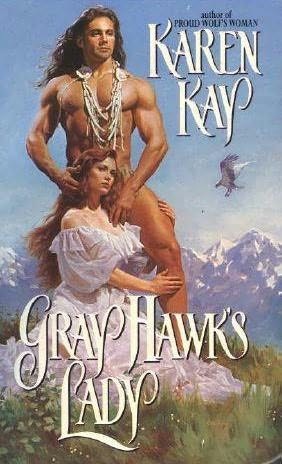 I had way too much fun googling "Indian dudes on romance novels" to find this pic. I had way too much fun googling "Indian dudes on romance novels" to find this pic. After I went to see that one play about Ishi (which was some of the most offensive, traumatic BS I’ve ever had to sit through) I think my tolerance (unfortunately) for bad, stereotypical nonsense has been set somewhat high. My initial response to this new opera, “The Lariat” was “well it’s not minstrel show bad” it’s more like Indian dude on the cover of a dime store romance bad. And, truth be told, it could have been worse. “The Lariat” described as a “dark comic opera” about the Mission Carmel, and the Esselen people is not really about the mission or the Esselen. The mission is the backdrop to a much more convoluted, tragic romance between Padre Luis who loves (unrequited) an Esselen woman (Ishka) but she loves a vaquero (Ruiz Berenda a.k.a Kinikilali) who is half Indian/ half Spanish. It’s based on a novella by a guy named Jaime De Angulo which was written in 1927. The fact that this opera is based on this old novella was a discussion point between me and my friend Angel. My final word on the subject was that the opera should stand on its own. The decisions of the writer, director, producers were made by these individuals in 2015 and stand as an approved portrayal of Native people in 2015. They chose these depictions, not just (or even if they are) because of an old novella. 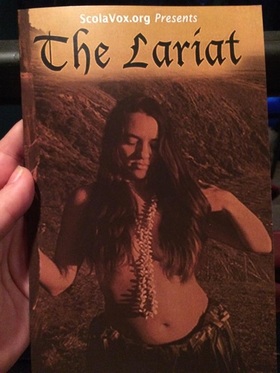 In the opera, Ishka is billed as a main character. In fact, she is featured on the cover of the playbill, topless, wearing some kind of grass skirt and necklace with the ocean in the background. This is the way she looks when you first see her, or when Father Luis first encounters her on the beach. The scene is supposed to be important, because she’s, I don’t know… boobs. But Ishka is not a main character in this story, neither are any of the Native people. No, this opera is about the missionaries. It’s about one Spanish dude (Father Luis) and the people he covets as “potential converts.” This is not to say that this is the worst thing I have ever seen or that I was ready to walk out of the opera. From a critical feminist standpoint this play is a full on misogynistic patriarchal mess. From a Native studies standpoint this play is not a play for Natives or even about Natives. The Natives are essentially moderately self-sufficient props. Nope, this is a voyeuristic look at Native people through western eyes. From a Cutcha Risling Baldy standpoint all I could really muster after the opera was over was “meh. Good thing I found some m&ms in my jacket pocket.” The Native person who gets the most pointed stage time is Ishka (or the Esselen girl, as she is also billed in the program) and her entire existence revolves around men. She is completely defined by the men in her life, who she in turn inspires to lust, greed, envy, wrath and pride (five of the seven deadly sins ain’t bad). And eventually they all die because they cannot have her, or because they want her too much. Interestingly enough, her songs are all in the Esselen language, so we never really get her perspective, because most of us don’t speak Esselen. When she does speak English, it is about what’s going on in her relationships, or with her men, or in her last song where she is begging for death so she can be with her man. There are many Native women (feminist Native women scholars, Native women leaders) who could have helped to inform a much stronger and more realized character than this Ishka. I kept wanting to apologize to Ishka. “I’m sorry that the playwright/opera writer didn’t want more for you. I’m sorry that you are stuck in a patriarchal, misogynistic trope you can’t get out of.” All the stereotypes are there. (If you want to learn more about Native Women and stereotypes read my blog entry on just that!) Stereotypes including: Native women are like the land so let’s tame and conquer them. After Ishka’s new true love (who is a vaquero) decides to marry her he goes to the woods and sings a song about how much he loves the land, even if it trembles at his touch, even if he can’t have it but just has to look at it and I thought “subtle dude.” Native women are meant to be lusted after, even though they are too “innocent” to know this. Their childlike innocence keeps them from being ashamed of their bodies. Ishka is introduced as a naked woman emerging from the sea, driving men to love her (Venus Demilo) and the thing I immediately write down is “what happened to the rest of her skirt?” For some reason she wore it as a loin cloth, to show all of her legs and barely cover her front and back. She is the natural, the wild, the beauty of the land. She is untamed, wilderness. The padre immediately lusts after her because, well this is never quite clear, but I mostly summarize his love for her as “bewbs.” Native women are tied to nature and spirituality. The defeat of this nature and spirituality will be accomplished through subduing Native women. At one point Ishka (the prop) passively accepts being baptized, which Father Luis pushes her in to doing because otherwise she will be lashed, even though she gets lashed anyway? She doesn’t understand what is going on, but kneels before him and allows him to drip water on her head. Then he starts singing about… wait for it… her bewbs. Native women don’t really like Native dudes. Native dudes kind of bum them out. Ishka and her old Shaman husband lose their baby, somehow? It’s not really clear. She leaves her Shaman husband after their child dies. He longs for her, she never mentions him again. He cries for her in the woods. She shows up to the woods and sings a love song with her new true love, a half Spanish half Indian guy who is the perfect example of assimilation – the padres like him because he is a Catholic, the Indians love him because he is an Indian and he loves her? Because? It’s never really established so maybe…bewbs. When the going gets tough the Native women get going because they long for progress, a “better future” and Native men are old and represent the past. The complete rejection of her Native life is incredibly problematic. I can only infer as an audience member that Ishka blames her Native life for her child’s death. This is a subtle hint that the Native life is bad for you, babies die in this life. She continues to reject her Native life throughout the opera. We hear nothing about her having any other family, as if her marriage to the Shaman is what defined her as a Native person. The other implication is that her marriage to the Shaman was forced, or arranged. And it is only after she goes to the mission that she is able to find “true love.” Again, the implied narrative is that Indian marriages are false, not based on true love, not real. If a Native woman ain’t got no man, then what’s she got to live for? (The future of her people? The rest of her family? To help fight for freedom from the missions? To help keep the other enslaved Esselen safe? To rejoin her community?) Sadly, the only agency Ishka demonstrates is when she decides to kill herself, so she can be with her man. As if she is lost and undefined. As she is singing her song, she begs to be taken to the land of the dead to be with her true love and I thought “which guy will show up?” Will it be her Shaman husband who she never divorced? (She could have divorced him, Native people had divorce). Or will it be her new vaquero (it’s the vaquero)? Other fun tropes that run throughout the opera: Indian people are sad and dying. One of my favorite moments (in song) was when the blue jays showed up to make fun of the crying Shaman and sing “Poor Indians, they are all kind of sad.” Indeed. Indian culture is dying. Indian children are dying. If you are in love with an Indian woman (because…bewbs) then you, much like the culture and children, will soon be dying! The dying Indian story has been told, and told, and told. Why? Because people like their Indians dying. It makes for better “dark comic operas” and also makes for a better excuse. There was tragedy all around. It wasn’t just the tragedy of the missions (which were tragic) but it was the tragedy of the west, it was “manifest destiny” or “manifest tragedy.” I don’t know. When I set out to write this review I thought “what will I say? It wasn’t the most horrible thing I’ve had to sit through.” Granted, there are a lot of problems. The portrayal of women, problem. The stereotypes, problem. The excusing of Mission violence, problem. Still, not the worst. The Ishi play was the worst. That’s what I was going to say. But then I wrote something down at the very end of my notes which I just came across. Set – higher – standards. 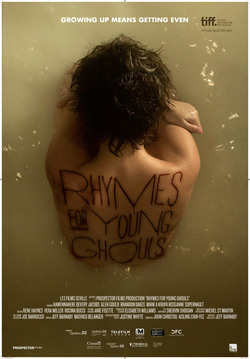 Go to Netflix and watch this movie instead of watching the opera. Go to Netflix and watch this movie instead of watching the opera. It was as much advice for myself as anyone else. Dear playwrights, play houses, and audience members: set – higher – standards. Yes, we can tell a better story than this. Yes, we should. Yes, when you take on the responsibility of writing about something or some people who are still struggling to be heard then you have to do more work. People still think the missions were nice places where Natives learned to farm and Padres kissed babies and brought “civilization.” Junipero Serra is being declared a saint! #HesNotASaint Native women suffer from some of the worst rates of violence, most of which are (still) committed by non-Native people. These stories matter and the way we tell them… matters. You should want to do more work. You should want to tell a better story. Ishka deserves better. The Esselen people deserve better. We all deserve better. The opera continues this weekend. You don’t have to go. Instead, head over to Netflix and watch this movie. You’ll thank me for it.
1 Comment
char·la·tan ˈSHärlədən,ˈSHärlətn/ noun Canonization (in American English and Oxford spelling) or canonisation (in British English) is the act by which the Catholic Church or Eastern Orthodox Church declares a deceased person to be a saint, upon which declaration the person is included in the canon, or list, of recognized saints. In the Catholic Church the act of canonization occurs at the conclusion of a long process requiring extensive proof that the person proposed for canonization lived and died in such an exemplary and holy way that he or she is worthy to be recognized as a saint. The Church's official recognition of sanctity implies that the persons are now in heavenly glory… or An act by the Catholic Church to erase and/or excuse the inhumane treatment of California Indians by the Franciscan missionaries (who would subject Native people to starvation, beatings, rape, humiliation etc.) that also demeans and dismisses these torturous/barbarous acts and elevates them to "righteous" sainthood. I am not the first, nor do I hope to be the last person to refer to Junipero as a “charlatan.” I got that from the late, great Dr. Jack Forbes who in his wisdom and poise called em like he saw him. He is greatly, and with all sincerity, deeply missed. Pope Francis decides to make Father Junipero Serra a saint OR In Which I Tell Pope Francis he needs to take a Native Studies class like stat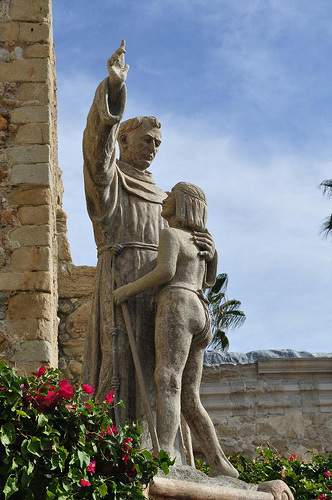 I find this statue super creepy TBH. I find this statue super creepy TBH. Today, the big news out of the Pope’s office is not that he is visiting the Philippines and the Philippine government is arresting homeless children to put them in jail so that the Pope won’t have to be confronted with actual poverty. No, today’s news is that he has decided (unlike other Popes) that he will declare Father Junipero Serra a saint. Pope Francis called Serra an "evangelizer of the west of the United States," and that he "has for centuries been considered a holy man" so Pope Francis will wave "Church rules that require a second miracle to be attributed to the candidate for sainthood after his beatification." Junipero Serra. [eyeroll] Junipero Serra is not a saint. What is Father Junipero Serra? He was a man. He performed no saintly public acts, no miracles (except the miracle that people are still insisting he could be a saint) and really what he is most responsible for in the annals of history is supporting, manufacturing and maneuvering a mass genocide of Native people during his run as the head of the Franciscan California Mission system. Yeah I said it. Lots of people have said it before me, but you probably haven’t heard about it before. The Missions in California, seemingly tasked with“converting” Native people to good, Catholic citizens of New Spain, were actually mass murdering, concentration camps tasked with subduing and controlling the land, people, flora and fauna of California at all costs. Oh, I’m just getting started.  Not my California Mission Project. Mom wouldn't let me do one. (Good job Mom) Not my California Mission Project. Mom wouldn't let me do one. (Good job Mom) In the fourth grade in California we are forced (mostly forced and/or told that we have to or something really bad will happen to us) to learn about the “great” California mission system. Much of California was “settled” (or invaded) by the Spanish beginning in 1769 as part of a massive mission system attempting to “civilize” and convert Native people to Catholicism. It resulted in 21 missions founded between 1769-1834 (though it is important to note that the Franciscian mission program was a continuation of efforts that started in Baja, california and Mexico and made their way through Southern and Central california). Led primarily by the Franciscans, the Mission System was a well oiled machine of colonization and demoralization. This was not the Spanish church’s first time at the rodeo. Having already forcibly colonized (demoralized, destroyed) Mexico for over 100 years, and having already established Franciscan Missions (the first in 1533) throughout the southern part of the Western hemisphere, they knew exactly what they were doing. Consider their means and methodologies against their own people during the Spanish Inquisition. I once went to a museum that was doing an exhibit on the torture devices of the Spanish Inquisition. It was an entire exhibit hall filled with various torture devices used by the Spanish against their own Catholic converts. It was creepy and a salient reminder that there are those of us who use our brains to invent sustainable ways to maintain the earth and care for our wildlife and assure the future of our planet and those of us who invent all kinds of torture devices. Or as my Great Grandfather wrote in 1971: "I have learned through my life that [Native peoples] were highly civilized, that of which will never be equaled. The civilization that is patterned from the materials that kills human lifes [sic] is poorly civilized." Students in California are often asked to build a model of a mission as part of their mission project. It often focuses on the architecture, and happy little Indian people in happy little gardens with happy little Franciscan missionaries all happily living in this happy place. Deborah Miranda (YAY!) compares it to having children make happy little plantations or happy concentration camps and turning those in. “That’s why it’s time for the Mission Fantasy Fairy Tale to end. This story has done more damange to California Indians than any conquistador, any soldado de cuera (leather-jacket soldier), any smallpox, measles, or influenza virus. This story has not just killed us, it has taught us how to kill ourselves and kill each other with alcohol, domestic violence, horizontal racism, internalized hatred. This story is a kind of evil, a kind of witchery. We have to put an end to it now.” -Deborah Miranda (xix) Holy crap she is awesome. The “mission mythology” is one that attempts to venerate the leaders of the mission system. They are the manifest destiny come to life, ordained by god and welcomed with open arms not only by the Native people, but by the land, just hungry for what the Priests were selling. This false (very false, epically false, insanely false) idea that everyone in the missions was happy is done on purpose. It’s a very easy way to erase the intent of genocide and to make it a sort of “whoopsey daisy” in history. “Whoops, we meant to bring you into our happy missions and make you civilized people but instead we killed over half of your population, enslaved you, forced you to procreate, committed violent acts against you and introduced violence into your relationships.” Junipero Serra was the "great evangelizer" and leader of this crazy train. Choosing to canonize him is choosing to canonize what he proliferated while he was running the mission system. Here are some things he proliferated, this soon to be canonized “saint”:
I guess Junipero Serra can be a saint for you Pope, but what that means is that the Catholic Church is saying that they venerate and believe that these torturous acts against Native peoples are not only righteous, but they are the true path to a holy, sainted life. And now comes the part where somebody says: “But he didn’t know it was wrong” or “he was a product of his time” and “for his time” he was way ahead of the game because it’s not like he just killed them, first he used them for labor and forced them to do things that he wanted them to do. That's what happens when you are a "product of your time" you don't know what you are doing is "wrong" per say. Well, a lot of people“of that time” knew it was wrong. Do you know who knew it was wrong? The Native people.
Other people who knew it was wrong: The French. “...We mention it with pain, the resemblance is so perfect, that we saw men and women loaded with irons, others in the stocks; and at length the noise of the strokes of a whip struck our ears.” (Jean Francois Galaup de La Perouse comparing the missions to slavery (1785-`1788) Other visiting explorers. “From all I saw, I must say the Spainards are bad men.” Other Spanish dudes. “The treatment shown to the Indians is the most cruel I have ever read in history. For the slightest things they receive heavy floggings, are shackled, and put in the stocks, and treated with so much cruelty that they are kept whole days without drink of water.” (Padre Antonio de la Conception Horra, 1799) “There is not a single mission where all the gentiles have not been scandalized, and even on the roads, so I have been told. Surely, as the gentiles themselves state, [Spanish] are committing a thousand evils, particularly those of a sexual nature. The Fathers have petitioned Don Pedro concerning these points, but he has paid very little attention to them.” (Father Jayme, 1772) “In a 1797 report written by Diego de Borica… Borica described how he entered [a dormitory that housed Native women] at an unidentified mission and was forced to leave the building because of the stench of human feces.” (Jackson & Castillo, 48) Suffice to say it seems like the only person who didn’t have any sort of qualms about their inhumane mistreatment of Native people in the mission system was… Father Junipero Serra. And now… Pope Francis. Pope Francis -- you really should take a Native American Studies Class like stat. Or read this book. Or both.  PS. Junipero Serra is not a saint. You can’t credit him with all the good stuff that happened in the missions and then say “all that other stuff, he’s not responsible for, that was OTHER people not him. He knew what was going on. He was okay with what was going on. He was the leader of what was going on. He set up the system. I’ll bet he even knew it was wrong. He just didn’t care. That’s not a saint, that’s an arrogant jerk with no morals. PPS. Just to be clear, because apparently we have to be clear about these things. Columbus isn’t a saint either. No I don’t know Jon Stewart. When Jon Stewart reads this (cause you know he’s sitting at his desk waiting for his Google Alerts to bleep like “OOOO who is writing about me now!”) I hope he goes “man I should listen to her, she has her own blog!” I have been thinking for a while about representation of Native people on TV. In my academic life I analyze the rare appearances of Native people who pop in and out of television shows as acceptable ways of “othering” Native people, as if they are only cameos in our society and culture. Also, these character tend to be male and do not have Native female counterparts. Native women are rarely mentioned as being part of a modern Native American culture and community. The same goes for something like The Daily Show where we get a spectrum of “correspondents” (who, yes, tend to be comedians in disguise/character) who speak about various issues but we have not had a Native voice as part of this discussion. (*Look, I know we haven’t had a lot of different representative voices. It’s not like The Daily Show has put together a perfect melting pot of voices. But I want a Native correspondent on The Daily Show so that’s where I’m putting my energy.) Sometimes Native people enter the realm of the show (see this episode about the Washington *RACIAL SLUR* team) but again… as cameos, people who can speak only about a particular issue almost like we have no stake in these other, very important issues that are a part of The Daily Show discourse. Also, when you have a non-Native filing this report, some of the things that get left out are the racism experienced by Native people from Washington fans, or the continued degradation of Native people who dare to go to the game. I have also been thinking about the many important issues that affect Native peoples and set global conversations, policies, ideas, directions for development, education, economy, cultural revitalization… etc. And yet, when I ask students, or audience members at presentations how many federally recognized tribes there are in the US I get answers that range from 2 – 10,000. (Right now there are 566, write it down, memorize it, there will be a quiz later). That’s right, people just don’t know. They don’t know because we don’t teach them and that’s why I teach Native American Studies, because they need to know. Native peoples are a significant part of our culture and society. We represent a past, present and future and our issues, news stories and events are not divorced from the rest of this space we now call the United States. Our representation has been decided for us on more than one occasion. People close their eyes and imagine an outdated Hollywood stereotype or a cameo. Natives become fictionalized so that their issues are treated as fiction. But we are fighting for water, fighting for fish, fighting to keep the environment safe for everyone, fighting to help Native parents keep their children, fighting to heal, fighting to represent ourselves. That’s a lot to take on for a correspondent, but I think it’s time. One of my students wrote this when I asked them to reflect on what they learned in my Native Studies course and for me it summed up exactly the reason why everyone should take a Native Studies course and why The Daily Show needs a Native correspondent: "It's almost as if we are trying to classify Native Americans as fictional beings other than people that were here long before the settlers were. If we view them in a fictional sense then it's easier for people to not take them seriously and to shrug off the oppression that occurred to them. It would be nice to see a shift in schools to teach the true history of the Native American people instead of just the fairy-tale parts. Which isn't even fair to the Native Americans because in a sense we are regarding their religious beliefs and culture as just whimsical stories instead of delving behind the true meanings of that too." So here goes… first blog post of the year. In Which I Write An Open Letter To Jon Stewart After I Promised Myself I Wouldn’t Do Open Letters Because They Are So Last Year or It’s Time for The Daily Show to have a Native CorrespondentDear Jon Stewart It’s time for The Daily Show to have a Native American correspondent. Heck, why not two? Why you ask? I made you a list: 5 Reasons Why The Daily Show should have a Native American Correspondent 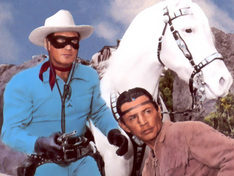 5. People can’t remember the last time they saw a Native on TV talking about news issues that are important to our country, our society, our communities and who we are as a civilization (all of us) like The Daily Show tends to do... That’s right Jon Stewart. I said it. The Daily Show, despite its claim to be nothing more than a comedy show that makes fun of the news, becomes an important part of the conversation. It’s comedy, but not in the sad way Fox News is comedy, instead in the happy way where people learn something, laugh, and (perhaps) have anecdotes for later that can help them to put in to words, gifs, clips, Facebook posts something they have been trying to say. Also, people look to The Daily Show as an illustration of what shows SHOULD look like. For instance, SHOULDN’T women of color be allowed to make reports about issues that face women of color? Yes (thank you Jessica Williams for being awesome). What happens when you put a woman of color on TV? (She drops the mic). What about a cool as a cucumber African American man? (He gets his own show). What about an arrogant white guy reporter (he gets his own show and then his own late show). So often Native voices are left out of this cultural response. Native people aren’t even invited to comment on Native issues and there is an assumption that Native issues don’t have a lot to do with what is going on in the rest of the world. And this representation (or non-representation) matters. Because it is here that we become stereotypes, mascots, fashion but not cultural lexicon and commentary. One of the exercises I do in my class is to ask students to tell me (1) the last time they saw a Native American on TV and (2) the last time they heard about a news story or issue that Native people are involved in. Here are some highlights for you from the past three years that I’ve been teaching:
I nominate that character to be your new correspondent! (PS. I’m sure your new Native correspondent will find many ways to make white people feel guilty, so I’m not that worried about filling that requirement actually.) 4. There are a lot of really important issues that are being led by, informed by, set by, made possible because of Native peoples Legal scholars call Native tribes the “miners canary.” It’s not just because the Supreme Court and Federal Government (and State and local governments and agencies) have historically made horrible decisions in regards to Native people, their sovereignty, their rights and their self-determination which then become the law of the land and (eventually) affect everyone else who suddenly discovers things like
But it is also because Native peoples are leading the way in a number of very important issues like:
Native people can speak to these, among many other issues that deserve an Indigenous analysis. For instance, lets say you want to do a report about how people are leading national/international protests against police violence. Well ask a Native. We are the group most likely to be killed by the police after all. 3. Representation combats mis-appropriation and encourages education. WHA! DROP…THE…MIC That’s right, representation matters. Help me, help you Jon Stewart. Help me, help you, to help all of us, better know a Native so that people will say “yeah I saw a Native on TV telling me about how awesome it is that Obama is vetoing the Keystone XL Pipeline because it is only going to be another environment polluting danger to our planet” instead of “Well, I did see Khloe Kardashian wearing a headdress on a re-run the other day…” 2. Native people are funny In 1969 Vine Deloria, Jr. wrote a chapter for his book Custer Died for Your Sins: An Indian Manifesto called “Indian Humor” where he noted that we are damn funny. Actually, he said this: “It has always been a great disappointment to Indian people that the humorous side of Indian life has not been mentioned by professed experts on Indian Affairs. Rather the image of the granite-faced grunting redskin has been perpetuated by American mythology.  That’s right, we are experts on cutting edge humor and satire that educates and informs. We are the original Daily Show. If you didn’t know this, it’s because our cameos, our representations, were and are stripped of humor because of the “tragedy” of the American Indian. That narrative was created to dehumanize us and to forward the American Dream - that American Indians were tragic people, who were slowly riding into the sunset of tragedy and would eventually disappear. And the new Americans would become the “Natives” of the future. Plus, Natives are supposed to be mean, rough and tough people, because that makes it easier to kill them. Despite all of this… genocide and tragedy… we are a funny people. You know that group of people in the restaurant laughing very loudly and telling stories, that’s us. It will not be hard to find a funny Native person to correspond on your show, I promise. Bonus List: Here are some people that would make good Native correspondents… Jim Ruel (I know him!)
Actually any of the comedians from this special. (RIP Charlie Hill!) Or this group. The 1491s.
Natalie Diaz Tiffany Midge Don't worry, I can go on if you need more.
Thank you Jon Stewart for all that you do, for your time, and because I know you will immediately compose an email to your producers saying "I had this great idea. We need to get a Native correspondent on the show." You're welcome. Sincerely with all sincerity, -Me |
SubscribeClick to
AuthorCutcha Risling Baldy is an Associate Professor and Department Chair of Native American Studies at Humboldt State University. She received her PhD in Native American Studies from the University of California, Davis. She is also a writer, mother, volunteer Executive Director for the Native Women's Collective and is currently re-watching My Name is Earl... (5) Top PostsOn telling Native people to just "get over it" or why I teach about the Walking Dead in my Native Studies classes... *Spoiler Alert!*
Hokay -- In which I lead a presentation on what happens when you Google "Native American Women" and critically analyze the images or "Hupas be like dang where'd you get that dentalium cape girl? Showing off all your money! PS: Suck it Victorias Secret"
In which we establish that there was a genocide against Native Americans, yes there was, it was genocide, yes or this is why I teach Native Studies part 3 million
5 Reasons I Wear "Indian" Jewelry or Hupas...we been bling-blingin' since Year 1
Pope Francis decides to make Father Junipero Serra a saint or In Which I Tell Pope Francis he needs to take a Native Studies class like stat
I need to read more Native blogs!A few that I read...
Archives
June 2020
Categories
All
|





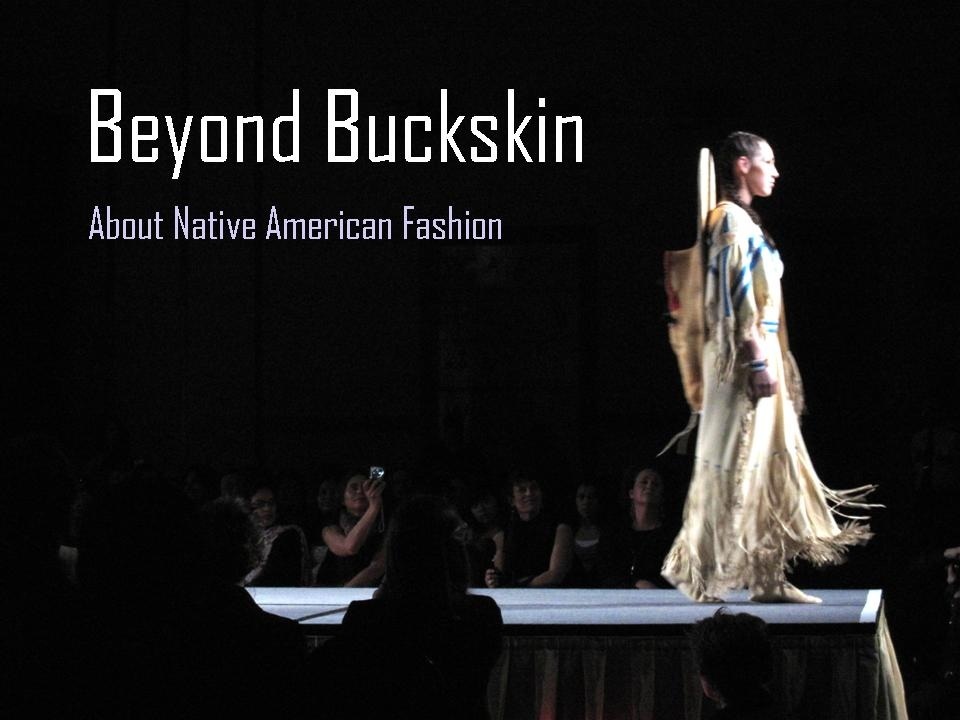

 RSS Feed
RSS Feed
